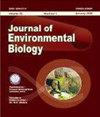http://jeb.co.in./journal_issues/202311_nov23/paper_12.pdf
IF 0.7
Q4 ENVIRONMENTAL SCIENCES
引用次数: 0
摘要
目的:本研究旨在确定一种合适的地衣物种,作为喜马拉雅栖息地重金属的生物指标。研究方法:研究在尼泊尔西部的一个圣林进行。小树林位于繁忙的 Mahakali 国道旁。地衣样本采集自小树林的不同区域,从毗邻高速公路的边缘到中心。采用标准程序对采集到的地衣物种进行鉴定。样本中的重金属含量通过酸消化后的 AAS 估算进行分析。结果:发现了三个地衣物种:Bulbothrix meizospora、Parmotrema tinctorum 和 Pyxine berteriana。Pyxine berteriana 采集于高速公路附近,而 Bulbothrix meizospora 和 Parmotrema tinctorum 采集于远离高速公路的地方。观察到的重金属生物累积模式如下:铁>铝>镁>锌>铜>铅>锰>镍>镉>铬。值得注意的是,在三个物种中,Pyxine berteriana 的金属浓度最高。解释:根据研究结果,可以得出结论:该地区的 Physcioid 地衣 Pyxine berteriana 是生命力最顽强的物种,可以作为研究环境空气中重金属沉积的适当生物指标。关键词Physcioid 地衣 Pyxine berteriana Parmotrema tinctorum 地衣 圣林本文章由计算机程序翻译,如有差异,请以英文原文为准。
http://jeb.co.in./journal_issues/202311_nov23/paper_12.pdf
Aim: The aim of this research was to identify a suitable lichen species as a bio-indicator for heavy metals in the Himalayan habitats. Methodology: The study was conducted in a sacred grove located in Western Nepal. The grove was situated alongside the busy Mahakali National highway. Lichen samples were collected from different areas of the grove, ranging from the edge adjacent to the highway to the center. Standard protocols were employed to identify the collected lichen species. The heavy metal content in the samples were analyzed by subjecting them to acid digestion followed by AAS estimation. Results: Three lichen species were discovered: Bulbothrix meizospora, Parmotrema tinctorum, and Pyxine berteriana. Pyxine berteriana was collected near the highway, while Bulbothrix meizospora and Parmotrema tinctorum were collected away from it. The heavy metal bioaccumulation pattern observed was as follows: Fe>Al>Mg>Zn>Cu>Pb>Mn>Ni>Cd>Cr. Notably, Pyxine berteriana exhibited the highest metal concentrations among the three species. Interpretation: Based on the findings, it can be concluded that the Physcioid lichen Pyxine berteriana is the most resilient species in the region and can serve as an appropriate bio-indicator for studying the deposition of heavy metals in the ambient air. Key words: Physcioid lichens, Pyxine berteriana, Parmotrema tinctorum, Lichens, Sacred Grove
求助全文
通过发布文献求助,成功后即可免费获取论文全文。
去求助
来源期刊

Journal of environmental biology
ENVIRONMENTAL SCIENCES-
CiteScore
1.70
自引率
0.00%
发文量
92
审稿时长
3 months
期刊介绍:
Information not localized
 求助内容:
求助内容: 应助结果提醒方式:
应助结果提醒方式:


